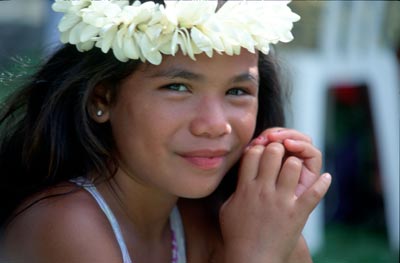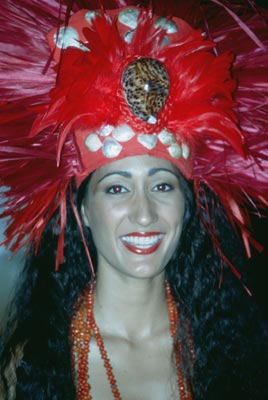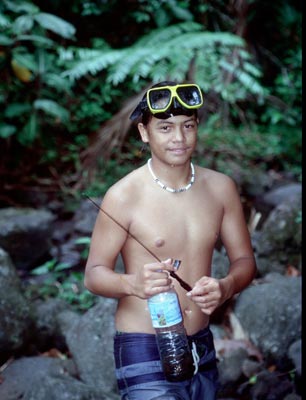Tahiti's glorious neighbor: Moorea
by Harvey Hagman, Fort Myers, FL
Tahiti’s jagged gray peaks pierced the opalescent dawn, the foaming white surf roaring and streaking along the sheltering reef, the surge coming to rest in a heart-stopping turquoise lagoon lined by a white-sand beach.
Where were we? On the island of Moorea in French Polynesia.
An introduction
If this wasn’t paradise, it was close enough for us. The sensuous siren French Polynesia had my wife, Kathy, and me in her grip — soaring tropical islands, turquoise seas, Garden of Eden vegetation and the friendly, smiling Polynesians saying “Ia Orana” and “Maeva” (“Hello” and “Welcome”).
To the right of our beach chairs sat the thatch-roofed overwater bungalows of Sofitel’s Moorea Beach Resort. Behind us rose Moorea’s lush, purple-green mountains. Birds swooped down, attempting to steal a morning snack off our deck. Nearby, a black chicken scurried after her four chicks.
As author James Michener once wrote, “Nothing on Tahiti is so majestic as what it faces across the bay.... To describe it is impossible. It is a monument to the prodigal beauty of nature.”
The heart-shaped island across the bay, pronounced Mo-oh-ray-ah in Tahitian, is halfway between Los Angeles and Australia, a 7½-hour flight from Los Angeles and a 10-minute flight or 45-minute ferry ride from Tahiti.
The population of 16,000, essentially Polynesian, has minimized the number and size of coastal resorts. The forests are lush, the lagoons pristine, the light scintillating and the colors surreal.
Moorea, like other Polynesian islands, was populated by navigators who arrived in large, double outrigger canoes from Southeast Asia about 1,000 years ago.
This island with no towns is famous for its colorful wraparound pareus, or sarongs. Once made of tapa, tree bark pounded flat, pareus today are worn worldwide at beaches.
Island touring
Our afternoon tour got off to a rainy start as a yellow Moorea Explorer jeep pulled up for our half-day off-road safari. We climbed in back with six others and donned plastic rain gear. The jeep’s sides were open — perfect for sunny days, but within minutes we were soaked.
We stopped at Cook’s Bay and passed around a 100-franc Polynesian coin on which the majestic bay was pictured. Above us, obscured by clouds, loomed Mount Tohiea, at 3,959 feet Moorea’s highest peak, and 2,660-foot Mount Moua Roa, called Bali Hai in the film “South Pacific.”
We warmed up at the Distillerie de Moorea with a choice of banana, vanilla and coconut liqueur, Mai Tais, piña coladas and flavored rums. Liquor was expensive there.
Our jeep bounced and slid as it climbed a rutted, muddy road up a volcano to an outlook atop a crater wall. This panorama of valley, bay and peaks is said to be unmatched in the South Pacific. We saw nothing but pelting rain.
Moorea’s temperature averages 79° and rarely goes above 89°. The rainy season, with alternating sun and rainy spells, extends from December to April.
We descended through the government’s agricultural station, a teaching plantation, where we passed coffee plants, pineapples, avocados, guavas, papayas, mangos and limes. Palms and grapefruit trees were interspersed with flowering hibiscus and birds-of-paradise. Goats and other livestock grazed.
Reluctantly, we skipped restored Marae Theodora, a pyramid-shaped stone temple complex once home to human sacrifice. On the archery platform, chiefs once competed in a sport reserved for them alone. Bows and arrows were never used in Polynesian warfare.
We sampled tasty, exotic fruit jams and learned about vanilla beans that must be hand-pollinated at 4 a.m. Our shivering group circled this island paradise before returning to our beach bungalows for steaming showers. Normally, the tour ends at a waterfall where everyone jumps in.
Here comes the sun
Morning dawned, the sun blazed, the skies cleared and, after a sumptuous Sofitel breakfast, we donned bathing suits and boarded Maco Tours’ ship, Spirit of Moorea. After our band of 24 filled the boat, our burly, smiling guide, Marcelo, joked, “It’s a perfect day. Please, no questions.”
Soon we were off to Opunohu Bay and Cook’s Bay, gazing at the sacred Mount Rotui that separated the bays. The shark’s-tooth peak stood in the center of an ancient crater, its black cliffs dropping dramatically into the world’s most photographed bays.
For the 1984 production of Mel Gibson’s “The Bounty,” the curving beach backed by shade trees and a valley were turned into Matavai Bay, on Tahiti. Marcelo pointed at the shores and said, “Once we barbecued missionaries over there.”
We anchored. Marcelo, clutching a handful of fish, dove into the transparent water. We all fed 3- and 4-foot stingrays, playful as puppies, their white undersides soft as velvet. Marcelo held them as they flapped, bikini-clad women screaming and husbands pointing their cameras. Others snorkeled off dark coral heads.
We pushed on to a tiny motu, or island, where Marcelo and hefty Elodi barbecued fresh chicken and beef and served rice, macaroni salads, fruits, coconut cakes, juices, beers and wines. We snorkeled, watched half-moon parasails lift surfers high into the air and followed the white sails of a regatta circling in the distance.
The scene was so idyllic, the food so tasty and the water so inviting that we laid in the lagoon’s shallow waters soaking it all in.
Resort relaxation
Back at the Sofitel, we swam, sipped half-price happy hour drinks and relaxed. As night fell, we adjourned to the Sofitel’s international buffet and the “Tiare Tarona” Polynesian show. Slim Tahitians wearing low grass skirts and shaking grass pom-poms danced the ori Tahiti, their hips shaking to frenzied drum beats, the flowers in their hair vibrating. The men danced the pa’oti, their knees opening and closing, scissor-like. The rapid-fire dancing was hypnotic.
Slower dances recalled the soothing rhythms of the hula. Dancers’ families clapped near us as two agile 7-year-olds stole the show with their shaking hips. It was a magical look into a simpler time.
We awoke the next day in our beach bungalow under twirling ceiling fans and white mosquito netting, then opened our sliding door and walked onto our deck to enjoy a view of Tahiti emerging from morning mists across the bay. We swam, had breakfast and laid back on the beach. Sometimes in Polynesia, the most enjoyable thing to do is nothing.
We were tempted to take a sunny safari tour; instead, we rented bikes and cycled the majestic 36-mile island road. One can also rent cars and motor scooters.
We could have gone deep-sea fishing, taken a snorkeling tour, had a dolphin experience — the shallow-water version, snorkeling with them or arranging a morning with only the dolphin and the trainer — or gone on a dolphin or whale watch. Or we could have joined a sunset cruise, raced around on a jet ski, pedaled a pedal boat, paddled a kayak, sailed a sailboat, water-skied or gotten a tribal tattoo at the tattoo hut.
Had we been honeymooners, we could have enjoyed a candlelight dinner on the beach or organized a romantic dinner in an overwater bungalow while a band played.
You name it, you can do it here. I’d recommend at least a week to drink in the silent glories of Moorea.
At the airport terminal, two roosters chased each other, providing the entertainment. There was no traffic, no parking problem, no bag search, just a quick, friendly check-in.
Planning a visit
Cheaper tours and less expensive flights from Los Angeles have put Moorea and Tahiti on the map. For more information on the islands, contact Tahiti Tourisme (El Segundo, CA: 310/414-8484, www.tahiti-tourisme.com).
For Sofitel’s Moorea Beach Resort (phone +689 551212 or, in the U.S., 800/763-4835 or visit www.sofitel.com), I recommend that you book early. Our 7-day vacation package, with extras, cost $2,093 per person. The dinners and buffets at the hotel were so delicious and varied that we ate all our dinners there.
Friends recommended another hotel on Moorea, Hotel Kaveka (877/354-5902, www.hotelkaveka.com). Rates start at $225 a day.
In Moorea, the most heavily booked months are June through October.
The Moorea Explorer safari trip cost $50 for a half day; the Maco tour cost $75 and lasted from 9 to 3. Both trips were booked through Sofitel.
We received excellent service aboard award-winning Air Tahiti Nui (877/824-4846, www.flyatn.com), which cost $1,028 per person from L.A.
Two great books to read while there are “Mutiny on the Bounty” by Charles Bernard Nordoff and James Norman Hall and “Tahiti: A Paradise Lost” by David Howarth.




